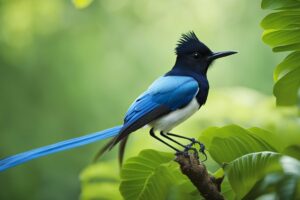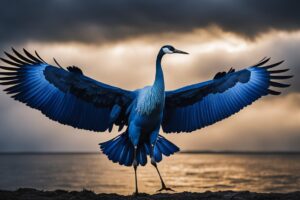Imagine us standing in the vast open stretches of the Arctic tundra, a white blanket as far as the eye can see.
It’s here, among the cold and desolate beauty, that the snowy owl—scientifically known as Bubo scandiacus—makes its home.
These majestic birds, cloaked in feathers as white as the snow they live on, might seem like mystical creatures from a far-off fairy tale, but they’re very real, and their secrets are just as fascinating as they are.

The snowy owl, the largest by weight of North American owls, is a sight to behold with its stunning white plumage that helps it blend into the icy background.
Contrary to what some might think, these owls aren’t exclusive to North America; they can also be found across the vast frosty expanses of Eurasia.
This means that whether we’re in Alaska or Norway, if we’re lucky and keep our eyes peeled to the horizon, we might just spot one of these elusive birds.
But why are these owls so perfectly suited for life in the Arctic?
It turns out they have some cool adaptations – and we’re not just talking about their feathers that keep them warm in temperatures that would have us shivering.
For instance, their white feathers are fantastic camouflage against the snow, and their sharp eyes can spot a meal from half a mile away!
So let’s nestle into this topic like a snowy owl into a warm, feathery snowdrift, and uncover the secrets of these breathtaking birds of the north.
Majestic Appearance

Let’s swoop into the enchanting world of the Snowy Owl and uncover the splendor of their majestic appearance.
With their snowy feathers and watchful eyes, these birds are mesmerizing marvels of the north.
Plumage and Size
Imagine us walking through a frost-kissed landscape as these white wonders stand out against the icy backdrop.
The Snowy Owl is indeed a large owl, with females typically being the heavier and larger counterpart, boasting a slightly more ample wingspan than the adult males.
Now, think of them as the ballerinas of the arctic, draped in immaculate white plumage that flutters and swirls as they pirouette through the air.
This isn’t just any ordinary white; it’s a pure, radiant white that glistens in the sunlight, playing hide and seek with flecks of gray and black that dot their feathers ever so elegantly.
Male Snowy Owls often become whiter as they age, like a wise old sage whose experiences show in their feathers.
Yellow Eyes and Wing Tips
Now let’s gaze into their captivating eyes!
Imagine the sun captured in two brilliant, golden pools—that’s the gaze of a Snowy Owl, full of wisdom and wilderness.
These yellow eyes aren’t just for show; they give Snowy Owls exceptional vision to spot their prey from great distances.
And those remarkable wing tips, when stretched out, reveal a wingspan that can be over four feet wide for the ladies of the species!
The tips are like the delicate brush strokes on an artist’s canvas, marked with dark bands that add just the right amount of contrast to their otherwise snowy wings.
With each powerful and silent flap, they demonstrate the grace and strength of a masterful hunter of the skies.
Habitat and Distribution

Let’s embark on a journey to discover where our stunning friends, the snowy owls, call home and how they make remarkable voyages as the seasons change.
Picture vast, icy landscapes and the sudden flutter of white wings—these are scenes from the life of a snowy owl.
Arctic Homelands
We snowy owls aren’t fans of crowded places, preferring the serene and expansive arctic tundra that stretches across North America and Eurasia.
This wintry wonderland is where we make our nests, and it’s as breathtaking as it is frigid!
Our homes are out on the open terrain, where the ground is a patchwork of grass, herbs, moss, and low shrubs.
Climate change poses a challenge, altering our habitat and making survival a bit trickier each year.
Winter Migration Patterns
When the Arctic chill becomes too much, even for us, we spread our wings and take to the skies, seeking milder climates.
We don’t all travel—some of us prefer to stick to our snowy homesteads—but for those who do migrate, there’s an intriguing pattern called an irruption.
This means that, every few years, a whole bunch of us might swoop down into areas like southern Ontario and the region around the Great Lakes.
You might be surprised to find us in more temperate coastal areas during these times too.
Isn’t it fascinating how we adjust our GPS to find the best spot for the winter?
And there you have it—a little peek into the “where” and “when” of our snowy owl lifestyle!
Diet and Hunting Techniques

In the icy realms of the north, we find the majestic snowy owl, a master of survival with an appetite for variety.
These birds aren’t just beautiful with their snowy feathers; they have some nifty tricks up their wings!
Predatory Strategies
Imagine we are snowy owls, silent and patient.
We use a special tactic called the “watch-and-wait” approach to hunt.
Rather than waste energy flapping around, we stay perched and keep a sharp eye out for any movement.
When a clueless lemming or an unsuspecting rodent scurries by, we swoop down without making a sound, thanks to our super soft feathers.
It’s like we have our own built-in stealth mode that makes us great at catching prey totally off guard.
A Varied Menu
Our meals are pretty interesting if we’re snowy owls. While those little lemmings are our favorite, we don’t just stick to one dish.
Our menu is quite the buffet, including voles, rabbits, and even other birds like ducks and ptarmigan.
And guess what? We’re also skilled fishers! When the mood strikes, we might snatch a fish right out of the water.
It’s important to mix things up because, let’s be honest, dining on the same thing every day would be pretty boring, wouldn’t it?
Plus, it keeps us strong and ready for anything the Arctic throws our way!
Reproduction and Lifespan

In the frosty realms of the north, we discover the mystical Snowy Owl, a dazzling bird whose reproduction and lifespan capture our imagination.
From their unique courtship dances in the Arctic chill to their tenacity in nurturing their precious young, these birds lead lives that are both intriguing and awe-inspiring.
From Courtship to Nesting
Imagine the Arctic tundra coming to life with the flutter of feathers and haunting calls, as Snowy Owls begin their romantic ballet.
Courtship is an enchanting time when males perform impressive aerial displays to woo their mates.
Once a pair bonds, they search for the perfect nesting site, which is usually a slight depression on the ground—nothing fancy for these regal birds, just a simple scrape on the tundra where safety reigns.
After courtship, things get serious.
Both parents work hard to create the nest, and when it’s just right, the female lays her eggs—usually about 3 to 11 of them, depending on how much food is available.
You might find it surprising, but Snowy Owls don’t build nests in trees like other owls because, well, trees are pretty scarce in their Arctic home!
Raising the Next Generation
The newly hatched owl chicks—fluffy and vulnerable—are called owlets, and growing up in the Arctic is no picnic!
Our majestic Snowy Owl parents are protective and attentive. They keep a close watch on their nest, and this is when their fierce side shows.
Anyone who dares to come near their precious family might just see a Snowy Owl swooping in to defend their offspring.
Did you know that these owls are actually diurnal, meaning they’re active during the day?
This is quite handy during the Arctic summer, with its 24-hour daylight, allowing the parents to hunt round the clock to feed their rapidly growing brood.
By late summer, the owl families are already preparing for the coming winter, and the young must quickly learn to fend for themselves.
Snowy Owls generally live around 10 years in the wild, but some have been known to live much longer, with a few celebrating their 20th birthday!
In their lifetime, these owls can raise many families, helping to ensure the survival of their enchanting species.
Frequently Asked Questions
Dive into our treasure trove of facts, and let’s discover the secrets of the Snowy Owls together.
With their ghostly feathers and mystical gaze, these birds have stories tucked beneath their wings that we’re eager to share.
How do the unique feathers of Snowy Owls help them hunt silently?
Our feathery friends, the Snowy Owls, have super-special feathers that allow them to fly without making a peep.
It’s like they have built-in silencers that give them ninja stealth in the air.
This hush-hush flying skill is key for sneaking up on unsuspecting snacks like lemmings and voles.
In what kind of environments can you find Snowy Owls living, and why do they prefer those areas?
Snowy Owls make their homes in chilly, open spaces like the Arctic tundra.
It’s like they have a taste for wide-open spots where they can scan for their next meal without any pesky trees blocking their view.
If they’re feeling adventurous and fly south, they still pick places that remind them of their frosty homes, like airports or the coast.
What are some of the most fascinating adaptations Snowy Owls have for surviving the freezing cold?
These cool birds are the kings and queens of the cold with their thick feathers that wrap around their bodies like the coziest down jacket you can imagine.
Even their powerful claws are fluff-covered to keep toasty in the deep freeze of the Arctic.
Can you share some interesting facts about the large eyes of Snowy Owls and what they can do?
Snowy Owls have massive peepers that give them superhero-like vision to spot their next meal from far away, even in dim light.
It’s like they have built-in binoculars! And those bright yellow eyes aren’t just pretty; they mean serious business.
What is the Snowy Owl’s role in spiritual beliefs and mythologies?
In stories told under the glow of the northern lights, Snowy Owls are mystical creatures, often seen as a symbol of wisdom or as messengers from beyond.
They carry secrets in their silent wings, weaving their way through legends and the dreams of those they inspire.
Why is the Snowy Owl considered a unique bird compared to other owl species?
Unlike their nocturnal cousins, Snowy Owls are like the early birds of the owl world, staying awake to hunt in the daytime.
They swap the night shift for the sunshine, showing off their snowy-white feathers and proving that you don’t have to stay up late to be a wise and mighty owl.










Add Comment